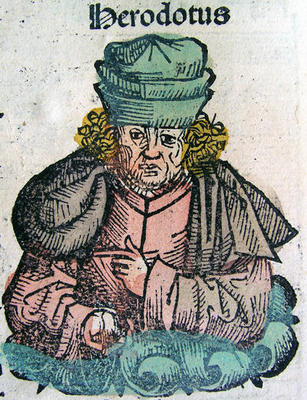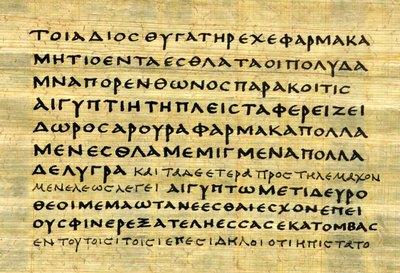
Herodotus, 484?—425? B.C., Greek historian, called the Father of History, b. Halicarnassus, Asia Minor. Only scant knowledge of his life can be gleaned from his writings and from references to him by later writings, notably the Suda. He traveled along the coast of Asia Minor to the northern islands and to the shore of the Black Sea; he also at some time visited Mesopotamia, Babylon, and Egypt. By 447 B.C. he was in Athens, and in 443 he seems to have helped to found the Athenian colony of Thurii in S Italy, where he probably spent the rest of his life completing his history. That classic work, the first comprehensive attempt at secular narrative history, is the starting point of Western historical writing. Among his grand digressions are fascinating histories of Babylon, Egypt, and Thrace, as well as detailed studies of the pyramids and specific historical events. The value of the work lies not only in its accuracy, but in its scope and the rich diversity of information as well as the charm and simplicity of his writing.
All Things Considered: The Rhetoric of Narrative Collage
Narrative collage, a term used by essayist Annie Dillard to describe modernist innovations in twentieth century fiction, takes on added meaning when applied to contemporary multimedia compositions: often such works comprise not only multiple voices but also a range of textual forms–film, music, photography, radio, even textiles and other objects, all in combination. Examples include Ken Burns’ 1990 film The Civil War, in which nineteenth century archival photographs, multiple narrators, first-person voice-overs, period music, and modern cinematography cohere to create a portrait of an era. Judy Chicago’s mixed media feminist installation The Dinner Party offers illustrated, labeled place settings for thirty-nine prominent women in history. In each case, historical research is presented through a multitude of voices and perspectives–a patchwork of different rhetorics and expressions woven together by a guiding consciousness into an integrated whole. In this course we will examine how narrative collages, ranging from simple story chronicles to more elaborate multimedia pieces, package information and make arguments for varied audiences and purposes. For example, The New York Times “Portrait of Grief” series, a collaboratively written collection of narrative snapshots of Americans who died in the September 11 th attacks, spoke effectively to a grieving citizenry, transcending the limits of traditional obituaries.
Wendy Goldberg, Stanford University, Program in Writing and Rhetoric; PWR2 Section Descriptions - Winter 2005
The Turn to a Narrative Knowing of Persons: One Method Explored
Denzin has recently proclaimed that the turn to narrative in the social sciences has been taken (Denzin 2001: 23), a fait accompli. One democratising practise within this paradigm shift is a renewed interest in biography as a method of knowing persons. He points out, "No longer does the writer-as-interviewer hide behind the question- answer format, the apparatuses of the interview machine" (30). The interviewer, finally, has come into the light as willing participant in a dialogical process. Crucially, narrative biography or 'story-telling' offers up the opportunity for democratising the experience of teller and listener (or performer and audience) by sharing the goal of participating in an experience which reveals shared "same-ness" (Porter cited in Denzin: 25). This has been expressed elsewhere as the concept of the “habitus —our second nature, the mass of conventions, beliefs and attitudes which each member of a society shares with every other member” (Scheff, 1997: 219). The paradox thus develops that by expressing individual differences, we uncover common ground.
“The rising popularity of biographical research tools may well lie in their aptness for exploring subjective and cultural formations, and tracing interconnections between the personal and the social" (Chamberlayne & King 2000: 9). In addition, the use of a biographical approach to understanding human concerns makes sense in that its methodology transcends the barriers of self/society as well as those of past/present/future. These include "barriers between the individual self and the collective society as well as those compartmentalising the past, present and future"
(Miller 2000: xiii).
Kip J. Ones, BA, MSC. PhD 2002
Contemporary Modernists -- A Dreadful Mouthful
Miss Dillard describes a method she calls ''narrative collage.'' Using this method, the writer creates a surface we are invited to view distantly, either because the point-of-view character is a joke - a dinosaur, a breast, a cow, an idiot, an axolotl (whatever that may be) or because the author is willing to expose himself as the artificer of the pattern. The elements exposed on the surface of the collage, sometimes startlingly but always with control, are fragments of time, fragments of narrative line, bits of character, causes separated from their effects, paradoxes and a randomness in spatial handling that deprives the work of any familiar setting and the action of any familiar context. ''So,'' she writes, ''the contemporary modernist deliberately flattens the depth elements in his art. He replaces the emotional strengths with intellectual ones.''
Vance Bourjaily's novels include ''Brill Among the Ruins'' and ''Now Playing at Canterbury.''
Expressivism and Social Constructivism
Expressivism encourages abundant brainstorming and freewriting, writing with honesty and candor to move the audience by the writer's voice. In contrast to Expressivism Social Constructionism focuses on how writers socially construct written texts:
1. Writers construct mental representations of the social contexts in which their writing is embedded;
2. Writing as a social process or system can create or constitute social contexts;
3. Writers -in some senses all writers -create texts collectively with other participants in discourse communities;
4. Writers assign consensual values to writing and thus construct a dimension of social meaning. (Rafoth, 2)
Thomas E. Gage

No comments:
Post a Comment